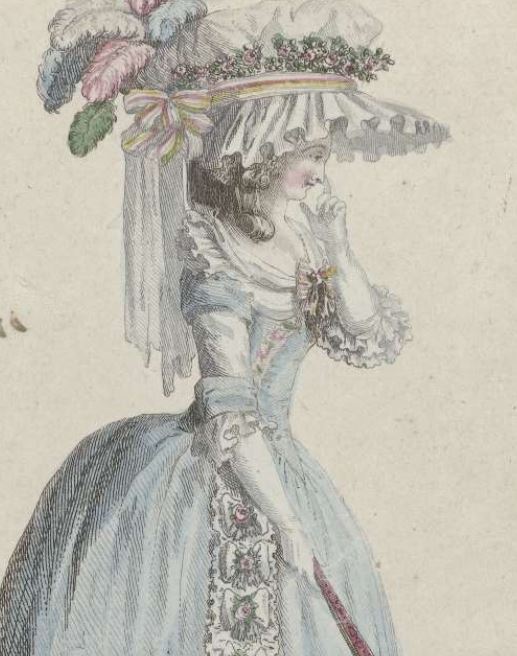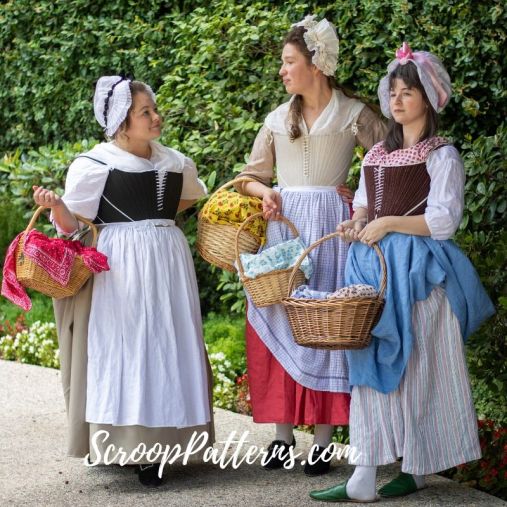18th Century stays are a weird animal to wrangle. They’re rather rigid and a totally different shape than we’re used to seeing in a natural body. In my previous post, I elaborated on the nuances of 1780s stays and how they’re different from their earlier and later counterparts…. but how are they supposed to fit on MY body?
Below I hope to help y’all out by showing you some graphics (bear with me, I have only recently started using a vector program!) to illustrate what to aim for and how to fix fit issues with any 1780s pair of stays you’re trying to make.
**The images and fit comments made in this post are in no way meant to criticize natural body figures or shame those that do not fit the ideal 18th century shape. These images are simply made to address specific fit issues using a basic template image to make the drawing process faster to produce**

COMFORTABLE FIT: Ultimately a pair of 1780s stays should be snug throughout, control the bosom by holding in the breasts just above the nipple thus creating a gentle mound above the top edge of the stays. They should crest mid-shoulder blades at the back and create a smooth, conical shape to the body. The highest cut of the tabs should reside comfortably just below the smallest part of the waist and should curve gently downward. A thrusted (or prow) center front is desired, but usually only achievable with a bust measure much larger than the waist- the body can be padded out to create this silhouette if desired.
LENGTH:
Length issues seem to the be the #1 problem most have with fitting a pair of stays. Too long and the stays dig into sensitive parts of the body or too short and bits of your body fall out. It’s very tricky stuff.
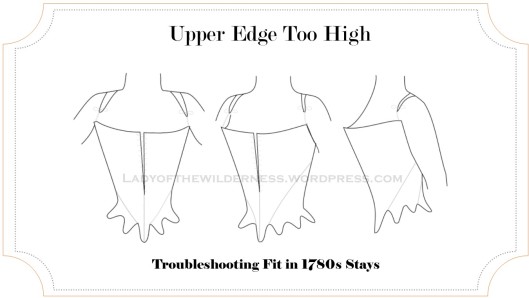
TOO HIGH ALONG UPPER EDGE: This image demonstrates what the top of the stays look like if they are too high. The tied points of the stays throughout the armscye dig into the arm and armpit. This can cause the bust to sink (have no support) OR to be too compressed and bring the bust too your chin. Issues that can result from this are chaffing/bruising in the arms from the upper edge, and chaffing at the bust too to excessive movement. This is not only uncomfortable but impractical for any sort of movement you may plan to make.
HOW TO FIX IT: If the stays are less than 1/2″ too high for your liking, shave the upper edge down to your desired height. If the stays are more than 1/2″ too high, the stay pattern should be shortened to the desired length. **Please note: Shortening the entire pattern piece is necessary for more than 1/2″ of difference because an inverted cone shape tends to have dramatic measurement differences as your lines go toward the floor- resulting in the bust measurement to be too small when the upper edge is merely shaved down.**

TOO SHORT ALONG UPPER EDGE: This image demonstrates what the top of the stays look like if they are too short. There is typically not enough bust support with this issue, so the bust tends to spill out and create extreme “muffin top-esque” shapes. Issues that can result from this are discomfort and/or chaffing in the breasts, pinching pain in the upper ribs and a visible top line of bust spillage that makes pinning your garment into the stays less feasible at the top edge.
HOW TO FIX IT: If the stays are less than 1/2″ too short for your liking, raise the upper edge to your desired height. If the stays are more than 1/2″ too short, the stay pattern should be lengthened to the desired length. **Please note: Just as with the above issue of shortening, it is necessary to lengthen the entire pattern piece for more than 1/2″ of difference because an inverted cone shape’s dramatic differences in measurements as you travel up and down the pattern. Simply redrawing the top edge could result in a bust measure that is too small or too large.**

TOO LONG AT WAIST: This image demonstrates what the waistline looks like if it is too long into the body. Hallmarks for this issue are a dramatic (almost 90 degree) curve in the waistline, resulting in very flippy tabs. Issues that can arise from this are cutting off circulation to the lower part of the body or causing kidney/lower back pain, pain in the pubic bone when sitting down, and broken boning if using reed or cane. It is not advisable to have this type of shape to your stays if you plan on moving a lot. **Other Fit Possibilities: This shape can also arise when the subject’s hip bone structure is very high and/or squared. If this is the case, tweaking the pattern slightly may be the only option, as the silhouette will largely remain the same due to bone structure.**
HOW TO FIX IT: If the stays are less than 1/2″ too long for your liking (or possibly too small at the waist) cutting the tabs slightly inward toward the waistline can help with this issue. If the stays are more than 1/2″ too long, the stay pattern should be shortened to the desired length. **Cutting tabs can result in the waistline of pattern enlarging slightly**

TOO SHORT AT WAIST: This image demonstrates what the waistline looks like if it is too high on the body. Hallmarks of this issue are a pain in the lowest part of the ribs and the center front tab to protrude more than 25degrees forward. Issues that can arise from this are pinching pain in the lower ribs and diaphragm as well as pain in the gut from being squished downward. This also results in an odd pointed tab that pokes forward at the center front of your petticoats. **Other Fit Possibilities: This shape can also arise when the subject has more mass in the front lower part of the abdomen. If this is the case, a wider wooden busk can alleviate the front protrusion but this may be the subject’s natural shape in the stays.**
HOW TO FIX IT: The stay pattern should be lengthened to the desired length according to your mockup and graded accordingly.
Also note: This higher style of waistline IS FASHIONABLE and correct for later 1780s-1790s and transitional stays.
BUST:
Fixing fit for the bust is an extremely hard task since bust tissue can vary in weight and density, have dramatic differences in sizes between sides and is generally an unstructured mass. Since it can be moulded and influenced into shape, having a mockup as a starting point makes fitting the bust far easier to pinpoint.

TOO SMALL AT BUST: This image demonstrates what the bustline looks like if the front pattern piece is too narrow. The bust is not completely contained and can be lifted uncomfortably high, and the tied points of the upper edge do not hold the sides of the bust in the stays. Issues that can arise from this problem are trouble breathing, pinching at the top of the ribs and chaffing on the skin along the upper edge.
HOW TO FIX IT: The front pattern pieces should be widened to desired width between tied points or graded up to the next pattern size for the upper edge. Sometimes widening the front pattern piece a small amount at center front can help if it is a small (less than 1/2″) amount of width. Using the measurement across the chest from armpit to armpit is a good starting place to fix this issue.

TOO WIDE AT BUST: This image demonstrates what the bustline looks like if the front pattern piece is too wide. The bust tends to sink into the stays- thus not being adequately supported- and the tied points of the upper edge dig into the arms and/or armpits. Issues that can arise from this are the stays causing rashes or blisters from excessive rubbing and the inability to sit in a comfortable posture.
HOW TO FIX IT: The front pattern pieces should be reduced to the desired width between tied points or graded down to the next pattern size for the upper edge. For reductions less than 1/2″, subtracting gently from the center front line to the mid point of center front may help. Using the measurement across the chest from armpit to armpit is a good starting place to fix this issue as well.

UNEVEN BUST: This image demonstrates what the bustline of the stays look like if the bust tissue is uneven. Issues that can arise from this are pain in the breast tissue and being generally unsupported and/or squished.
HOW TO FIX IT: Fit the majority of the issues to the larger side of the bust as indicated with the above troubleshoot fixes. For the smaller side of the bust, a bust support- or “cookie” as it’s called in the costuming world- can be made to supplement the lesser bust tissue and tacked into the stays once they are finished. Various shapes can be made depending on your needs: For less full tissue try a crescent shape for support. For less-existent tissue try a half circle made with knit fabric to fill out the area.
WAISTLINE:
The waistline… ahhh… the part we’re all vain for. 18th century stays don’t generally make for a great tightlacing situation- as the conical shape and flare of the waist can be very dramatic if laced improperly and cause a host of issues for the abdomen. For the most part, 1-3″ of reduction is the norm, though some who are more squishable can achieve more of a reduction. Since the dawning of tightening garments, there have been oodles of satirical images and such regarding their “dangers” and the silliness of those who vainly want to achieve the smallest waist measure. Those sentiments should be taken with a grain of salt. 18th century stays were a practical garment for bust and back support and of course can be used for altering the body shape if desired- but for the most part people go with… and went with… what’s comfortable.
WAISTLINE ANGLES: These images demonstrate the differences in angles that can be achieved with stays. Some of them are dependent on bone and body structure, but for the most part, we try to aim at Image B where the angle of the waistline tabs are between 20-30 degrees upward toward the back.

WAISTLINE PARALLEL TO GROUND: Image A demonstrates a waistline that is parallel to the ground. This can result in the posture being thrown backward and the front lower abdomen/hips to angle uncomfortable downward. Issues that can result from this are a sore lower back, kidney pain, pain in the shoulders and spine and/or pain in the abdomen. **Other Fit Possibilities: For those with more mass in their lower abdomen or who have low glutes, this shape might be perfectly normal and needed for their body shape**
HOW TO FIX IT: First, tighten or add adequate straps. I have noticed that many people who do not have straps added to their mockups bring this issue to my attention and it is quickly resolved once the straps adjust the overall angle of the stays. If straps do not fix the issue then try either snipping the tabs more inward at the waistline as you make your way toward the back OR gradually shortening your pattern pieces toward the back.
WAISTLINE SEVERELY ANGLED: Image C demonstrates a waistline that has an extreme (more than 35degree) angle upward toward the back. This can result in the posture being thrown far forward- similar to an S-bend corset- and the abdomen/hips to angle upward and outward. Issues that can result from this are a sore lower back, pinched rib pain in back, pain in the shoulders and spine and/or pain in the pubic bone when attempting to sit. **Other Fit Possibilities: For those who have high glutes or a more severe curve in their lower lumbar this shape is perfectly normal and needed for their body shape**
HOW TO FIX IT: Loosen the straps or shorten the pattern pieces gradually toward the front as needed.
BACKS:
The following images will address fit issues by looking at the backs of the stays. 18th century stays are intended- and amazing- for back support, so addressing where the backlines should be is important for a comfortable fit. The goal is parallel, vertical lacing and back pieces that rise to the midpoint of the shoulder blade.

BACK PIECES TOO WIDE: This image demonstrates a back piece that is too wide for the body. The back of the armscyes dig into the arms/armpits and the top back of the stays can close very easily. Issues that can arise from this are chaffing/blistering of the arms and armpits as well as straps that fall off the shoulders easily.
HOW TO FIX IT: Decrease the width of Center Back Panel at the top edge as needed and grade down to the proper waist measurement. If the decrease results in taking away a piece of boning, split the difference between Center Back and Side Back panels so as not to compromise the structure of the stays. If the back issue is too wide at the armscye edge, shave away along the armscye the desired amount until a level of comfort is reached.
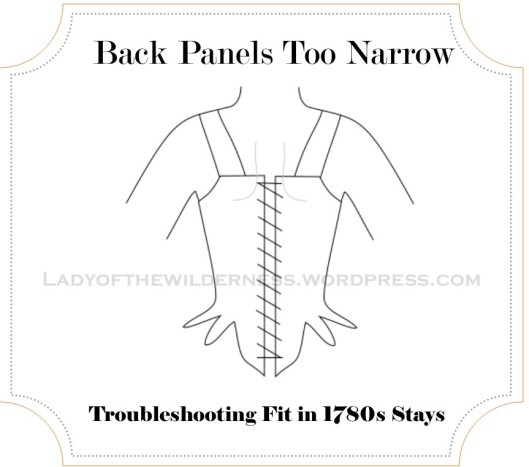
BACK PIECES TOO NARROW: This image demonstrates a back piece that is too narrow for the body. The back of the armscyes dig into the back, can create spillage of back tissue and pull the arms back into an extremely proud posture. Issues that can arise from this are chaffing/blistering of the back tissue as well as sore shoulders and spine.
HOW TO FIX IT: Increase the width of Center Back Panel at the top edge as needed and grade down to the proper waist measurement. If the increase is more than 1/2″, split the additions between Center Back and Side Back panels so as not to compromise the overall angles of pattern pieces and grade to waist. If the back issue is too narrow and cuts into the back at the armscye edge add more area along the armscye to the desired amount until a level of comfort is reached.
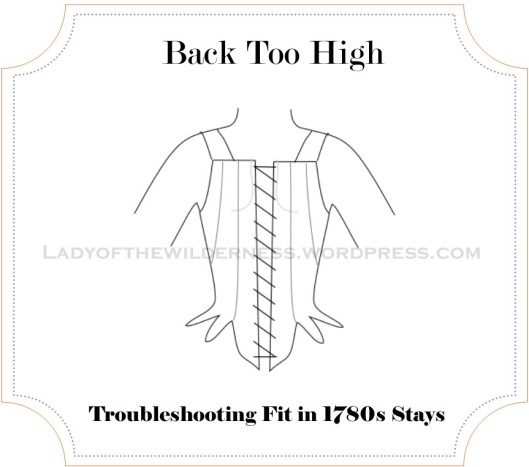
BACK PIECES TOO HIGH: This image demonstrates a back piece that is too high for the body. The top line of the back piece sticks out, creating a severe line visible when wearing garments. Issues that can arise from this are chaffing on the back from excessive movement and straps that are too loose.
HOW TO FIX: If less than 1/2″ of decrease is needed, simply shave off the desired amount to the top lines of the pattern pieces. If more than 1/2″ of decrease is necessary, shorten each of the back pattern pieces to desired amount.

BACK PIECES TOO SHORT: This image demonstrates a back piece that is too short for the body. The top line of the back piece digs close-to or underneath the shoulder blades, creating tissue spillage visible when wearing garments. Issues that can arise from this are chaffing/blistering/bruising on the back from excessive movement and uncomfortable straps.
HOW TO FIX: If less than 1/2″ of increase is needed, simply add the desired amount to the top lines of the pattern pieces. If more than 1/2″ of increase is necessary, lengthen each of the back pattern pieces to desired amount.
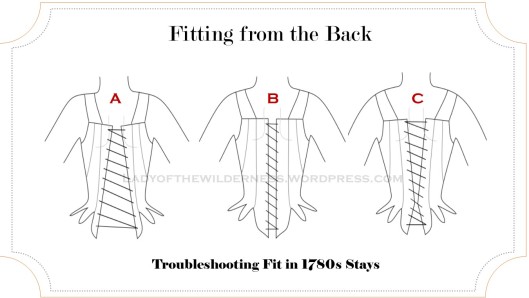
WAISTLINE TOO SMALL: Image A demonstrates what the back looks like when the waistline of the garment is too small for the body. The lacings look away from eachother and are in the shape of an upright triangle. This is typical with weight gain and/or a wrong angle of the pattern pieces for the body shape. **Other Fit Possibilities: If using the Augusta Stays Pattern, this can result from using the “Curvy Silhouette” on a “Straight” body type. **
HOW TO FIX IT: Increase the waistline measurement between all pieces except the front panel to needed amount OR grade to the waist measurement of the next size up in your pattern. If using the “Curvy Silhouette” of the Augusta Stays Pattern, try using the “Straight Silhouette.”
WAISTLINE TOO BIG: Image C demonstrates what the back looks like when the waistline of the garment is too large for the body. The lacings invert toward eachother at the waist and are in the shape of an upside-down triangle. Issues that can result from this are chaffing at the waist from excessive movement and broken boning. **Other Fit Possiblities: If using the Augusta Stays Pattern, this can result from using the “Straight Silhouette” on a “Curvy” body type. **
HOW TO FIX IT: Decrease the waistline measurement between all pieces except the front panel to needed amount OR grade to the waist measurement of the next size in your pattern. If using the “Straight Silhouette” of the Augusta Stays Pattern, try using the “Curvy Silhouette.”
EASY FIT FREEBIE:
STRAPS FALL OFF SHOULDERS: Shorten straps OR Move the straps more toward center back, creating a slightly more severe angle for those who have more sloped shoulders.

We had too much fun at CoCo 2019. Photo Taken be Leimomi Oakes of ScroopPatterns.com
If you’ve made it this far, BRAVO TO YOU. You’ve read over 2700 words of text and I’m already tired writing it… If all this is too much for you to deal with right now and would like hands-on fitting help from yours truly, I’ll be available for a class in June 13th & 14th 2020 with Twins N Needles to help you fit your mockup and prepare you to make your very own pair of Augusta Stays 🙂 Do check out the link if you’re interested!
Happy Fitting and Happy Making, everyone!

